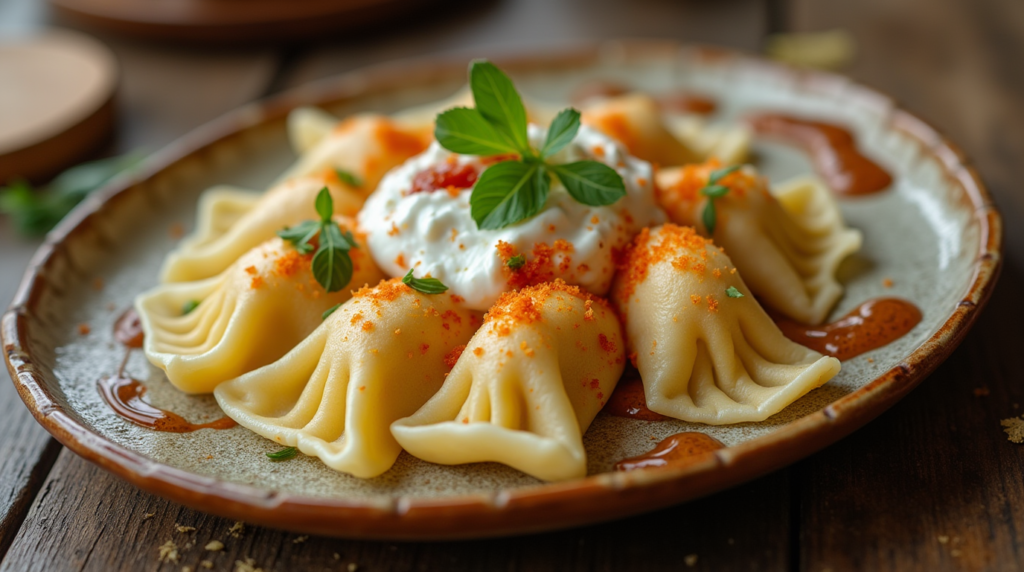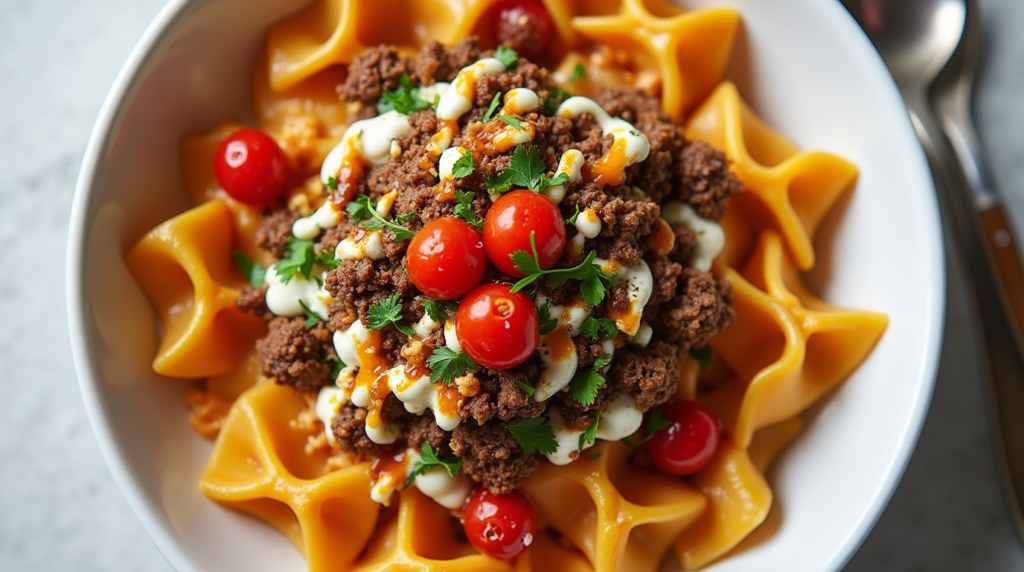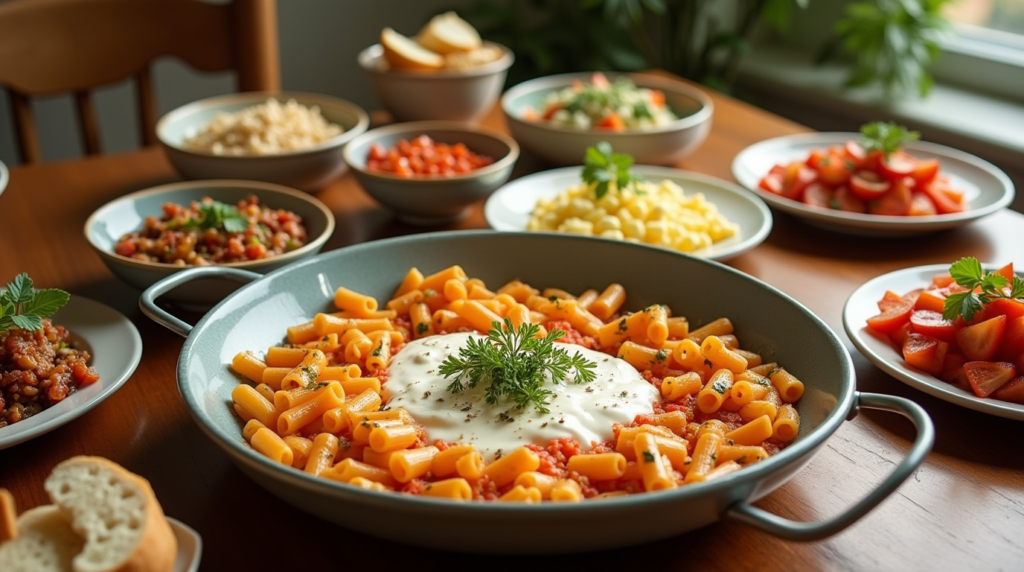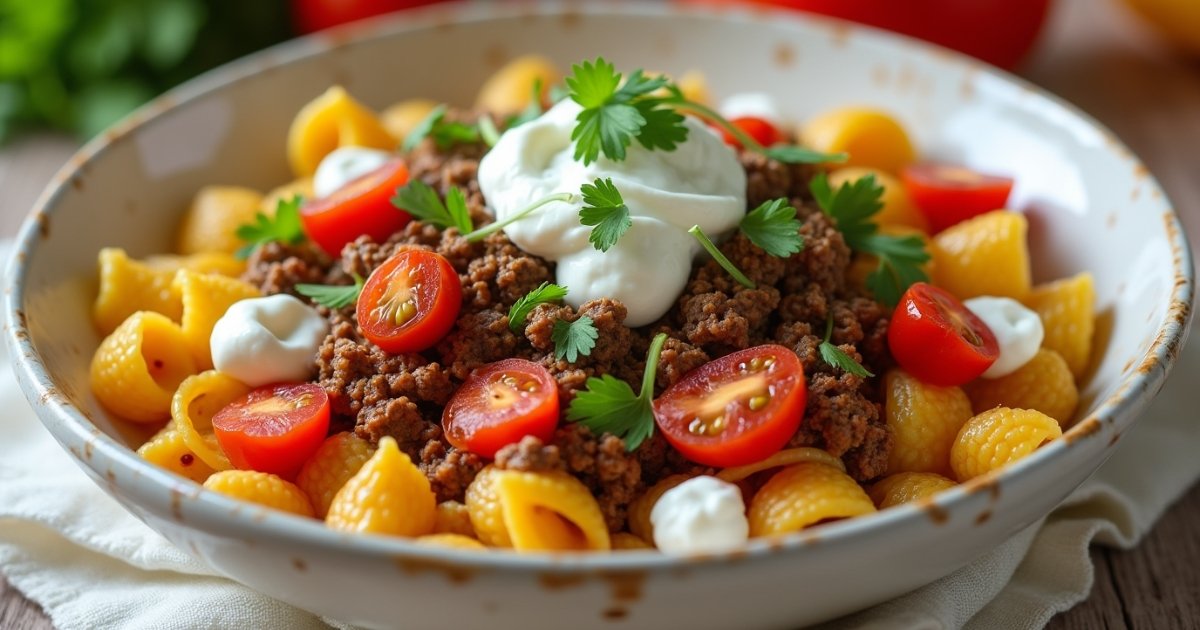What is Turkish Pasta? Easy Turkish Pasta Recipe Explained
Table of Contents
Traditional Turkish manti requires hours of preparation time. This viral Turkish pasta recipe revolutionizes the classic dish into a quick 30-minute weeknight meal. Anna Paul’s TikTok video made this recipe an internet sensation that delivers 30 grams of protein per serving.
The simple Turkish pasta with yogurt brings together lean ground beef, creamy garlic yogurt sauce and a signature paprika butter drizzle. The recipe uses ingredients accessible to more people and packs 526 calories with 40 grams of protein per serving. This nutritious alternative saves time compared to the original version.
Let’s discover how this dish evolved from traditional manti to a social-first phenomenon. This piece breaks down the key ingredients and provides step-by-step instructions to help you create this viral sensation in your kitchen.
The Origins of Turkish Pasta: From Traditional Manti to Internet Fame
Turkish pasta’s trip began when nomadic Turkish tribes moved from Central Asia to Anatolia in the 11th century. Turkish pasta has carved its own unique path that’s different from Italian traditions. Its roots run deep in traditional cuisine and cultural practices.
What is authentic Turkish manti?

Manti is one of Turkey’s most beloved dishes. These tiny handmade dumplings filled with spiced meat are the life-blood of what people now call “Turkish pasta” on the internet. Real manti uses spiced meat, usually lamb or ground beef, wrapped carefully in thin dough sheets. You can boil or steam these dumplings. This dish takes a lot of work to make and has been part of Turkish cuisine for generations.
Making traditional manti takes incredible detail and care. Each dumpling needs careful handcrafting that takes hours to complete. People usually make authentic manti together as a family. They prepare the dough from scratch, fill it with spiced meat, and fold each piece by hand. The whole ordeal can last entire afternoons or evenings, so it’s more of a special occasion dish.
A yogurt topping with garlic and spices like red pepper powder and melted butter makes this dish special. The size of manti carries the most important cultural meaning in Turkish homes. Smaller dumplings show more respect for guests.
How Anna Paul’s TikTok changed the dish

Anna Paul’s viral TikTok video in early 2024 pushed Turkish pasta into the global spotlight. Her mother showed a simpler version that kept the traditional manti flavors without spending hours in the kitchen.
People call this viral version “cheat manti” or “yalancı mantı” (meaning “fake dumplings”). Paul’s approach uses pasta that’s accessible to more people instead of handmade dumplings. She tops it with quickly cooked beef or lamb, garlic yogurt sauce, and butter infused with paprika.
The video spread faster than wildfire across social media. Many people tried to make it at home. Turkish creators who saw the trend pointed out that you need cumin to get that authentic Turkish taste.
Why this simplified version appeals globally
There’s another reason why this simpler Turkish pasta caught on worldwide. The dish needs basic ingredients that most people already have in their kitchen. You can make it in under 30 minutes instead of hours, perfect for weeknight cooking.
The dish tastes amazing and balanced. These ingredients work together perfectly:
- A filling pasta base
- Flavorful spiced meat
- Sharp garlic yogurt
- Rich paprika butter on top
You get complex flavors that taste fancy even though it’s easy to make. Many comments on viral videos say the dish is “speedy, delicious and ‘picky kid approved'”.
Turkish food has become more popular worldwide lately. Turkey makes and exports the second-most pasta globally. People in 166 countries keep taking Turkish pasta. This strong foundation helped this particular dish become so popular.
This viral sensation shows how food brings people together across cultures. A traditional dish became available to everyone while keeping what makes Turkish food special. Social media showed us how a complex cultural dish can become an everyday meal without losing its soul.
Essential Ingredients for the Perfect Turkish Pasta Dish

The perfect Turkish pasta dish needs a good understanding of what makes its unique flavor stand out. The pasta base, signature paprika butter and other elements all play a vital role in creating this social media sensation.
The pasta base: What works best
Short pasta shapes are perfect for this Turkish pasta recipe. They catch all the tasty sauce and meat topping really well. Here are the best options:
- Bow tie pasta (farfalle) – the one used in Anna Paul’s viral video
- Shell pasta (conchiglie) – similar to traditional manti’s shape
- Orecchiette – great at holding the yogurt sauce
- Penne, fusilli, or rigatoni – all work well too
These shapes create lots of spaces that hold the meat and creamy yogurt, giving you amazing flavor in every bite. You can use your favorite gluten-free pasta if you need to avoid gluten.
Spiced meat mixture: Traditional vs. viral version
The meat is usually lean ground beef (85-90%), but ground lamb, turkey, or chicken work great too. The viral version seasons the meat with sweet paprika, onion powder, salt, and pepper. Some people add dried mint, cumin, or curry powder to improve the taste.
Traditional manti filling mixes finely minced onions right into the meat. The viral version cooks diced onions first before adding the ground meat. There’s another difference too – the viral recipe makes the meat crispy in spots, which tastes amazing with the creamy yogurt sauce.
The vital garlic yogurt sauce
Without doubt, the garlic yogurt sauce makes this Turkish pasta special. You need plain Greek yogurt (full-fat works best), mixed with crushed or minced garlic and salt. This tangy, creamy sauce balances out the meat and spices perfectly.
Anna Paul’s viral video showed her mom adding crushed garlic and salt to Greek yogurt. In spite of that, some people add lemon juice to balance the garlic or a bit of water to thin it out. The yogurt sauce cuts through the rich meat and makes the spices pop.
Paprika butter: The finishing touch
The signature touch that makes Turkish noodles authentic is the paprika butter sauce. This simple addition lifts the dish from good to amazing. Just melt unsalted butter and mix in sweet paprika to create a bright red drizzle that looks and tastes incredible.
Some recipes add Turkish red pepper paste to the butter sauce, but tomato paste works fine if you can’t find the traditional stuff. The warm, paprika butter creates an amazing contrast with the cool yogurt. This mix of flavors explains why this dish became one of the biggest food trends that ever spread online.
Step-by-Step Guide to Making Viral Turkish Pasta
Want to make this amazing dish at home? This Turkish pasta recipe that took over social media is simple to follow, whatever your cooking skills. Let me show you how to make each part – from the yogurt base to putting it all together.
Preparing the garlic yogurt base
Mix 1-2 cups of plain Greek yogurt (full-fat works best) with 2-3 cloves of minced garlic and about 1/2 teaspoon of salt in a small bowl. You can add a tablespoon of fresh lemon juice to make it tangier. Mix until you get a smooth, creamy blend. Let this sit while you work on the other parts so the garlic’s flavor seeps into the yogurt.
Cooking the spiced meat topping
Get a large skillet hot over medium-high heat. Add 1 pound of ground beef straight to the pan – no oil needed since the meat has enough fat. Break it up with your spatula as it cooks. Once it starts browning, add one finely diced yellow onion and keep cooking.
Season your meat with 1-2 teaspoons each of paprika, curry powder, and onion powder. Add salt and pepper to taste. Cook until the beef turns brown and gets crispy bits around the edges – about 7-10 minutes. These crispy pieces create a nice contrast with the yogurt sauce’s creaminess.
Creating the signature paprika butter
Melt 4 tablespoons of unsalted butter in a small saucepan over medium-low heat. Add 1 teaspoon of sweet paprika and a pinch of salt once it’s melted. Some people like to add 1/4 teaspoon of red pepper flakes for a bit of heat.
Keep the heat low so the paprika doesn’t burn and turn bitter. The butter should bubble and turn a bright red color – this takes about 1-2 minutes. Take it off the heat but keep it warm until you’re ready to serve.
Assembly techniques

Here’s how to put your Turkish pasta with yogurt together:
- Put your cooked pasta in serving bowls or plates
- Add 3-4 tablespoons of garlic yogurt sauce on top
- Add plenty of spiced meat
- Pour 1-2 teaspoons of paprika butter over everything
- Top with halved cherry tomatoes and chopped fresh parsley
The best way to enjoy this dish? Let everyone mix their portions right before eating. This gives you the perfect combination in every bite – creamy yogurt, flavorful meat, warm pasta, and rich butter sauce all coming together. It’s no wonder this Turkish pasta became such a hit online.
Common Mistakes to Avoid When Making Turkish Noodles
Simple dishes need attention to detail, and this viral Turkish pasta recipe proves this point. The dish looks easy to make, but you might miss that perfect taste and texture that made it an internet sensation. Let’s get into the most common mistakes and their solutions.
Overcooking the pasta
The foundation of any good Turkish pasta dish starts with perfectly cooked noodles. Home cooks often boil pasta longer than needed, which creates a mushy texture that can’t stand up to heavy toppings. You should cook your pasta according to package directions until it’s al dente—with a slight firmness when you bite it.
Start checking your pasta 1-2 minutes before the package time suggests. Of course, you might like softer pasta, but note that it continues to cook after draining from the leftover heat. A tablespoon of olive oil tossed with drained pasta prevents it from sticking while you work on other ingredients.
Underseasoning the meat mixture
Ground turkey or beef needs proper seasoning or it tastes bland. This is a vital step for authentic Turkish pasta with yogurt. Many cooks play it safe with spices and end up with flat flavors that lack depth.
Your meat mixture needs time to develop rich flavors through generous seasoning and proper cooking. The longer your ground meat simmers with spices, the better your dish will taste. Make sure to cook your spices until they release their aroma (about 30 seconds) without burning them.
To boost flavor, try these strategies:
- Sauté fresh minced garlic and chopped onions with your ground meat
- Use beef broth or beef-flavored bouillon to deepen flavor when cooking with turkey
- Let the meat develop crispy edges in spots for textural contrast
Rushing the butter infusion process
Paprika butter makes Turkish noodles special, but many cooks rush this step. The butter sauce needs gentle heat to infuse the spices properly without burning them and creating bitter flavors.
You might want to turn up the heat to save time, but this could burn the delicate spices. Good butter infusion with paprika and seasonings takes just 1-2 minutes over medium-low heat. The spices should bloom in the butter to release their essential oils and flavors.
Timing plays a big role—make the butter drizzle right before serving. The sizzling sound isn’t just for show; it adds to the aroma and flavor that makes this Turkish pasta recipe impossible to resist.
How Turkish Pasta with Yogurt Compares to Other Global Pasta Dishes
Turkish pasta with yogurt stands out among pasta dishes from Italy to Turkey. Each country’s version tells its own story through unique ingredients, cultural importance, and nutritional benefits.
Flavor profile differences
Turkish pasta takes a different path from Italian pasta when it comes to sauce. Italian pasta lovers stick to tomato or cream-based sauces, while Turkish cuisine uses tangy yogurt as its base. The yogurt sauce, which gets a boost from garlic, creates a perfect balance with rich meat toppings and paprika butter drizzle.
The spice choices tell two different stories. Turkish pasta brings Middle Eastern flavors like cumin, sweet paprika, and sometimes curry powder to the table. These spices create a stark contrast to Italian herbs like basil and oregano. Turkish chefs insist that cumin plays a crucial role in capturing the authentic taste.
Italian chefs mix their pasta with sauce, but Turkish pasta with yogurt uses layers. This method lets each ingredient shine with its own flavor and creates an interesting contrast between cool yogurt and warm spiced meat.
Cultural significance
Turkish cuisine has a special relationship with pasta. Italy might be pasta’s birthplace, but Turkey ranks second worldwide in pasta production and exports. The country’s pasta industry started with its first factory in İzmir, now a 101-year-old establishment.
Turkish people eat about 8 kilograms of pasta yearly, which doesn’t match Italy’s 21 kilograms or Greece’s 17 kilograms. But Turkey exports pasta to 166 countries, showing its global reach.
Traditional Turkish homes often serve “erişte” (Turkish noodle). Modern packaged pasta has become more common because it’s practical. The viral Turkish pasta recipe shows how this dish has adapted – a modern take on traditional manti flavors.
Nutritional comparison
The viral Turkish pasta recipe packs more nutrients than typical Italian dishes:
- Each serving contains about 40g of protein
- One portion provides 526 calories
- Greek yogurt adds probiotics and extra protein
Durum wheat makes Turkish pasta special. This wheat grows naturally in Turkey’s Mesopotamia region, known as the crop’s “genetic heartland”. The result? Pasta that’s firmer and more nutritious than versions made with regular wheat.
The yogurt brings calcium and probiotics to the dish. These nutrients aren’t found in cream or tomato-based pasta sauces, which makes Turkish pasta a healthier choice than many other versions worldwide.
Conclusion
Turkish pasta with yogurt shows how traditional recipes evolve naturally in today’s world. This viral sensation captures Turkish flavors perfectly, even though it differs from authentic manti. The recipe works great for busy home cooks.
The distinctive flavors are now accessible to more people through simple ingredients. Everyone loves how the garlic-infused yogurt sauce combines with paprika butter. These elements create an unforgettable taste that made this dish popular worldwide.
This simple version packs 40 grams of protein per serving and stays true to authentic Turkish flavors. Traditional manti might be the purist’s choice, but this adaptation shows how beloved recipes can evolve while keeping their cultural soul.
The dish works perfectly for quick weeknight dinners or gatherings with friends. It combines practicality with culinary excitement. Just grab your ingredients, follow the steps, and you’ll soon find out why this dish became an internet sensation.
FAQs
Q1. What is the viral Turkish pasta recipe? The viral Turkish pasta recipe is a simplified version of traditional Turkish manti, featuring pasta topped with spiced ground beef, a garlic yogurt sauce, and a paprika butter drizzle. It gained popularity through social media, particularly TikTok, for its quick preparation time and delicious flavor profile.
Q2. How long does it take to make this Turkish pasta dish? This simplified version of Turkish pasta can be prepared in about 30 minutes, making it a convenient weeknight dinner option. It’s much faster than traditional manti, which can take hours to prepare.
Q3. What are the key ingredients for the viral Turkish pasta? The essential ingredients include short pasta (like bow tie or shell), ground beef, Greek yogurt, garlic, paprika, and butter. Additional spices like cumin or curry powder are often used to enhance the flavor of the meat mixture.
Q4. Is the viral Turkish pasta recipe nutritious? Yes, this dish is quite nutritious. It provides approximately 40 grams of protein and 526 calories per serving. The use of Greek yogurt adds probiotics and additional protein, making it a balanced meal option.
Q5. How does this Turkish pasta differ from Italian pasta dishes? The main differences lie in the sauce base and spice profile. Turkish pasta uses a yogurt-based sauce instead of tomato or cream-based sauces common in Italian dishes. It also incorporates Middle Eastern spices like cumin and paprika, creating a unique flavor profile distinct from Italian herbs like basil and oregano.
Leave a Review & Rate This Recipe!
There are no reviews yet. Be the first one to write one.

